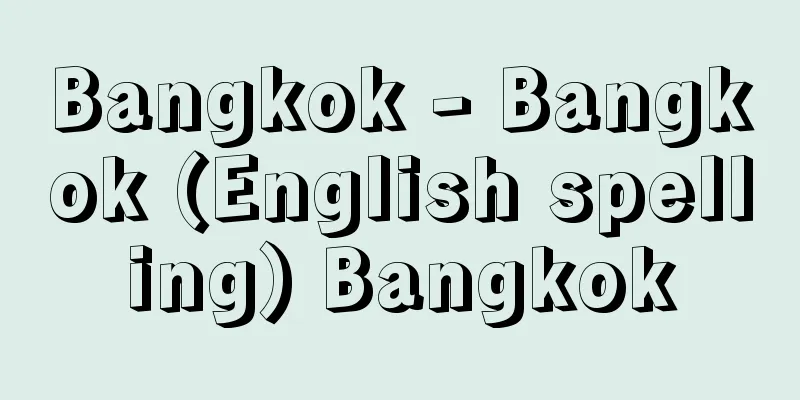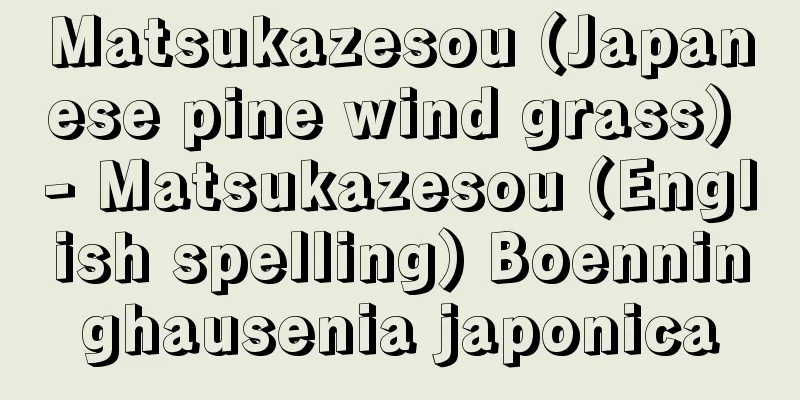Bangkok - Bangkok (English spelling) Bangkok

|
The capital of Thailand. Foreigners call it Bangkok, but Thais call it Krungthep (City of Angels). It is located on the left bank of the Chao Phraya River, in the lower Chao Phraya Delta in central-southern Thailand, where it meanders westward and forms an arch. Together with Thon Buri on the opposite bank, it forms the Bangkok metropolis. It has a population of 6,355,144 (2000). It has a typical tropical monsoon climate, with an average annual temperature of 28°C and an annual range of only 4.8°C, making it hot all year round. It receives 1,492 mm of rainfall annually, with most of the rain falling between May and October. It is the center of all Thai political, economic, and cultural activities, as well as an important center of Southeast Asia, with international air routes converging and various United Nations organizations being established there. The city is roughly divided into two areas, the old and the new. The old city is centered around the Royal Palace on the east bank of the Chao Phraya River, and is surrounded by three canals, the Roth, Bang Lamphu, and Phadon Krung Kasem, which connect the upper and lower reaches of the river in an arc. In addition to the Royal Palace, the old city includes large temples such as Wat Phra Kaew (Temple of the Emerald Buddha) and Wat Pho (Temple of the Reclining Buddha), government offices, and Chinatown. Outside the Phadon Krung Kasem canal (east side) is the new city, which has been urbanized since the 20th century. The northern part of the new city is a residential area stretching from Dusit to Bang Sue, and in the area close to the old city are Chit Radya Palace, Wat Benchama Bophit (Marble Temple), the Parliament Building, and the zoo. In the southern part of the new town, many shops are concentrated in the area formed by New Road and the four roads that branch off from it to the east: Siphia, Surawongse, Silom, and Sathorn, forming a shopping district. To the north, new commercial areas are developing along the main roads of Petchburi, Rama I, and Rama IV. Many roads branch off from Sukhumvit Road, an extension of Rama I Road, on both sides of which new residential areas are spreading. Many foreigners also live here. As Bangkok expands from the old city to the new city, the transportation system has changed from water to land, and the scenery that was once called the "Venice of the East" has disappeared, turning the city into a place of overwhelming automobile exhaust fumes and noise. In addition, the conversion of waterways to land has made it difficult to treat rainwater, and the city is often subject to serious urban flooding. Furthermore, the population is growing at over 3% per year, creating a housing shortage, and new housing is expanding unplanned into the suburbs, creating many urban problems that are difficult to solve. [Takashi Tomosugi] historyUntil the mid-16th century, the Chao Phraya River meandered widely around present-day Bangkok, hindering shipping, so under King Phrachai (reigned 1534-46), a short-circuit canal was excavated. This is why it is marked "Bangkok Island" (I. de Bangkoc) on maps made by Frenchmen in the 17th century. King Narai (reigned 1656-88) built artillery batteries here to protect against invasion by foreign enemies. In 1767, Ayutthaya was destroyed by an attack by the Burmese army, but Taksin, who repelled the invaders, did not rebuild Ayutthaya when he restored order, but instead established Thonburi, known to Westerners as Bangkok, as the new capital. In 1782, Chakri, who succeeded Taksin, moved the capital to the opposite bank and called it Krung Thep. This is today's capital of Thailand. Historically, Bangkok's population structure was extremely diverse, which clearly shows the international character of the port city. According to a French missionary who lived here in the mid-19th century, half of the capital's population of over 400,000 were Chinese, 120,000 were Thai, and the rest were Laotians, Vietnamese, Cambodians, Hmong, Malays, and Burmese. Bangkok is surrounded by the meandering Chao Phraya River on the west, and three canals were excavated in concentric arcs toward the east, with a network of smaller canals connecting various parts of the city. In 1862, during the reign of King Rama IV, the "New Road" was built as the first full-scale road. [Yoneo Ishii] The largest river in Thailand runs through Bangkok city. In the background is Wat Arun Temple in Thonburi. Bangkok, Thailand ©Masashi Tanaka "> Chao Phraya River and Arun Temple Source: Shogakukan Encyclopedia Nipponica About Encyclopedia Nipponica Information | Legend |
|
タイの首都。外国人にはバンコクとよばれてきたが、タイ人はクルンテープKrungthep(天使の都の意)という。タイ中南部、チャオプラヤー・デルタ下流部の、チャオプラヤー川が西に蛇行して弧を描く地点の左岸に位置し、対岸のトンブリーと一体となってバンコク・メトロポリスを構成する。人口635万5144(2000)。典型的な熱帯モンスーン気候に属し、年平均気温は28℃、年較差は4.8℃にすぎず、年間を通して高温である。年降水量は1492ミリメートルで、降雨は5~10月に集中する。タイの政治、経済、文化など、あらゆる活動の中心であるとともに、国際空路が集中し、国際連合諸機関が設置されるなど東南アジアの重要な中心にもなっている。 市街は新旧の2区域に大別される。旧市街はチャオプラヤー川東岸の王宮を中心として、同川の上流と下流を円弧状に結ぶ、ロート、バン・ランプー、パドン・クルン・カセムの3運河で囲まれる。旧市街には王宮のほかに、ワット・プラ・ケオ(エメラルド寺院)、ワット・ポー(涅槃(ねはん)寺)などの大寺院、官庁街、チャイナタウンなどがある。パドン・クルン・カセム運河の外側(東側)は新市街で、20世紀以後都市化した。新市街の北部はドシットからバン・スーに連なる住宅地で、旧市街に近い地域にチト・ラドゥヤ宮殿、ワット・ベンチャマ・ボピット(大理石寺院)、国会議事堂、動物園などがある。新市街の南部ではニューロードとこの通りから東に分岐するシピヤ、スリウォン、シーロム、サートンの四つの通りで形成する地域に多くの商店が集中し、ショッピング街を形成している。また、その北方はペッブリ、ラーマ1世、ラーマ4世などの幹線道路に沿う新興商業地域が展開する。ラーマ1世通りの延長であるスクムウィット通りの両側から多くの道路が分岐して新興住宅地が広がる。外国人も多くがここに居住する。 バンコクが旧市街から新市街に拡大するに伴って、交通体系は水路から陸路へ変化し、かつて「東洋のベニス」と称された景観は失われ、おびただしい自動車の排気ガスと騒音の街に変化している。また、水路の陸路化は雨水の処理を困難とし、しばしば深刻な都市洪水の被害を受ける。さらに年3%を超える人口増加によって住宅が不足し、新しい住宅は郊外へ無計画に膨張しつつあるなど、解決困難な多くの都市問題を抱えている。 [友杉 孝] 歴史16世紀中葉まで、現在のバンコク付近はチャオプラヤー川が大きく蛇行して舟運の妨げとなっていたため、プラチャイ王(在位1534~46)のとき、短絡運河の掘削が行われた。17世紀にフランス人が作成した地図に「バンコク島」I. de Bangkocと記されているのはそのためである。ナライ王(在位1656~88)はここに砲台を築いて外敵の侵入に備えた。1767年、アユタヤはビルマ軍の攻撃によって破壊されたが、侵入軍を撃退したタークシンは、秩序の回復に際してアユタヤを再建せず、西洋人にバンコクの名で知られたトンブリーを新都に定めた。1782年、タークシン失脚の後を受けたチャクリは、首都を対岸に移し、これをクルンテープとよんだ。これが今日のタイの首都である。歴史的にみると、バンコクの人口構成はきわめて複合的で、港市のもつ国際的性格をよく示している。19世紀中葉ここに住んだフランス人宣教師によれば、首都の人口40万人強の半数が中国人、12万がタイ人、残りはラオ人、ベトナム人、カンボジア人、モン人、マレー人、ビルマ人であったという。西側を蛇行するチャオプラヤー川に囲まれたバンコクは、東方に向かって3条の運河が同心円弧状に次々に掘削され、これらをつなぐ小運河網が市内各地を連結していた。1862年ラーマ4世のとき「ニューロード」が初めての本格的道路として建設された。 [石井米雄] バンコク市内を貫流するタイ最大の川。写真奥はトンブリーに建つアルン寺院(ワット・アルン)。タイ バンコク©Masashi Tanaka"> チャオプラヤー川とアルン寺院 出典 小学館 日本大百科全書(ニッポニカ)日本大百科全書(ニッポニカ)について 情報 | 凡例 |
<<: International Law - Bankoku Koho
>>: Half engineering, half learning (English: half engineering, half learning)
Recommend
Shisha Pangma (mountain) (English spelling)
The highest peak in the Langtang mountain range in...
Officer Candidate School - Kanbuko Hosei Gakko
An institution that educates officer candidates fo...
Grass cutting - Kusakezuri
A farm tool used for removing weeds and piling up ...
Towiański, A.
…In Paris, the greatest intellectuals of the time...
Harmony Society
A Lutheran community established in Pennsylvania i...
Shiragagoke - Shiragagoke
A general term for the moss Leucobryum genus of th...
Class solidarity - class solidarity
…It refers to the close ties formed by individual...
Anjou
A prominence on the solar photosphere. Usually, fl...
Cantaloupe
...In Japan, it refers to three varieties of West...
Yusaku Uehara
An army officer from the Meiji to Showa eras. Bor...
Trommelsieb
...This device was developed at the Dutch State M...
Applaud
A linguistic term coined by J. Grimm. Also known a...
Trevi Fountain - Trevi Fountain
This fountain is located in Trevi Square in Rome, ...
Izena [village] - Izena
…Okinawa Prefecture, located northwest of Okinawa...
Katahigashi [village] - Katahigashi
A village in Nishikanbara County, central Niigata ...









